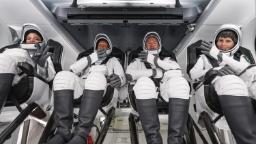[ad_1]

Sign up for CNN’s Wonder Theory science newsletter. Explore the universe with news on fascinating discoveries, scientific advancements and more.
CNN
—
Four astronauts are expected to board a SpaceX Crew Dragon capsule and return home from the International Space Station on Friday, bringing an end to their nearly six-month stay aboard the orbiting laboratory.
The astronauts — NASA’s Kjell Lindgren, Bob Hines and Jessica Watkins as well as Italian astronaut Samantha Cristoforetti with the European Space Agency or ESA — shared goodbye hugs with other astronauts on the space station and strapped into their spacecraft around 10 a.m. ET.
The Crew Dragon spacecraft left its docking port at the ISS around noon ET, and it’ll burn its engines several times to gradually lower its altitude. It’s expected to splash down off Florida Friday afternoon.
The crew was initially scheduled to depart the space station Wednesday evening, but ground crews waved off that attempt due to rough weather. Storms also dashed a second attempt at the return Thursday morning.
As of Thursday afternoon, NASA was monitoring potential weather issues at the crew’s designated splashdown sites, noting that a cold front was passing through Florida, according to a statement. Weather officials had confidence that Friday’s weather would be more favorable as a high-pressure system moved into the area.
Weather delays of spacecraft launching or returning from the space station is common, especially as unpredictable storms batter the spashdown sites off Florida.
The Crew Dragon spacecraft that will bring the astronauts home typically has seven potential landing zones – just off the coast of Pensacola, Tampa, Tallahassee, Panama City, Cape Canaveral, Daytona and Jacksonville.
NASA and SpaceX are targeting Jacksonville for Friday’s splashdown.
This mission, called Crew-4, has marked a historic first, with Watkins becoming the first Black woman to join the space station crew for an extended stay.
During their stay, the astronauts conducted science experiments, including research on how to grow vegetables in space without soil and the study of spaceflight effects on the human body.
Those experiments are designed to help astronauts understand how they may one day grow their own food and how their bodies may react on missions deeper into space, such as on NASA’s planned Artemis moon missions, Watkins said during a news briefing last week.
“It’s been awesome to be able to walk into the Columbus module and smell the smell of leaves growing, of plants growing,” Watkins told reporters.
Cristoforetti, who was on one previous mission to the space station in 2014-2015, is the sole woman in ESA’s astronaut corps, and she made history of her own on this mission. Last month, she took over as commander of the space station, becoming the first European woman to do so.
Cristoforetti also conducted a spacewalk in July to deploy small satellites and work on the installation of a new robotic arm on the space station’s exterior.
[ad_2]
